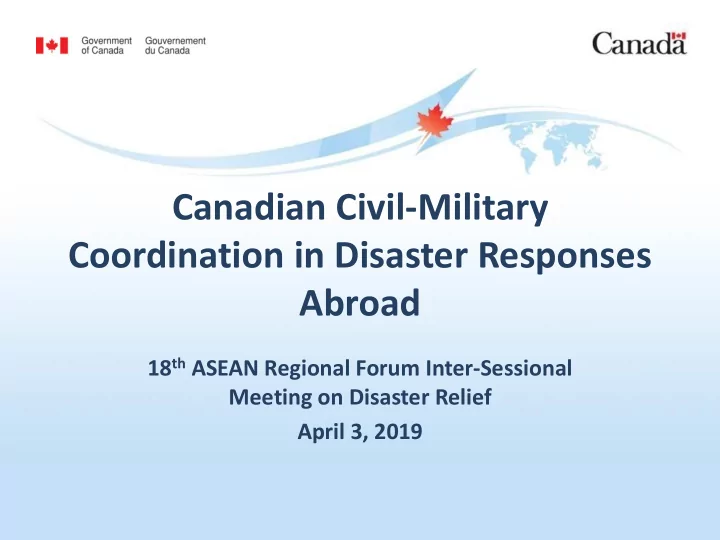

Canadian Civil-Military Coordination in Disaster Responses Abroad 18 th ASEAN Regional Forum Inter-Sessional Meeting on Disaster Relief April 3, 2019
Civil-Military Coordination: Defining the Issue • Natural disasters are becoming more frequent and more complex. • The use of military assets in humanitarian responses has also grown considerably. • Maintaining an open dialogue between civilian and military stakeholders is essential. • How and when military assets should be used in a humanitarian context requires careful guidance.
Civil-Military Coordination: Defining the Issue • Canada recognizes that there are areas where the military possesses unique capabilities that can be called upon in response to a natural disaster. • When calling on military assets to provide support, Canada’s response underscores respect for humanitarian principles and the operating environment . • The use of military assets remains a last resort and based on needs.
Use of Canadian Military Assets: Criteria • Exceptional/ catastrophic natural disaster/emergency; • As a provider of last resort; • Request by impacted government; • Based on needs assessments : Information from deployed Canadian Disaster Assessment Team (CDAT) on appropriateness of military assets; • Permissive environment; and, • Decision of Prime Minister based on joint recommendation from Global Affairs & DND
Use of Canadian Military Assets: Potential Support • Airlift; • Naval assets; • Logistics; • Intelligence & Reconnaissance; • Essential engineering; • Command/control/communication; and, • Disaster Assistance Response Team (DART) – 300 personnel (in uniform), approx. 40 day deployment – Light engineering; medical and water purification.
Canadian Guidelines on Humanitarian Action and Civil-Military Coordination Canadian Guidelines Canadian Objectives: • • Adhere to international guidelines: Ensure civilian character of Oslo (natural disasters); humanitarian assistance; MCDA (complex emergencies); • Effective, highly coordinated civilian/military coordination useful to • Promote integrated government address gaps in civilian response – approach: needs based not supply driven; GAC & DND developed guidelines together; • Last resort – Canadian Forces assets one element of Canadian response • Underscore key humanitarian principles ; toolkit; • Identify areas where Canadian Forces and humanitarian actors may need to cooperate; • Provide guidance on ensuring respective operational imperatives do not conflict; • Consistent with CAF policy, doctrine and operational practices;
Some Key Principles • To the greatest extent possible, CAF operations should be conducted with a view to respecting the humanitarian operating environment. • CAF provision of direct humanitarian assistance in response to emergency needs should be the exception, not the rule . • Humanitarian activities supported by CAF indirect humanitarian assistance or infrastructure support must retain their civilians nature and character. • Plan a transition and exit strategy to avoid the creation of dependencies or humanitarian response gaps.
Civil-Military Coordination in Action: Typhoon Haiyan Response Observations and Best Practices: • Multi-faceted CDAT membership facilitated development of civil-military recommendations for humanitarian response; • Immediate contact with local/provincial authorities and the United Nations invaluable in identifying local humanitarian needs; Transparency • Co-location of DART HQ in the local Coordination Centre essential in informing humanitarian actors of Canadian intentions; • GAC civilian liaison officers embedded with DART to provide guidance/advice on how to support humanitarian action; Coordination and Transition • Worked closely with OCHA and other humanitarian actors, local authorities, donors to ensure effective transition strategy; • CAF Operations were needs driven and did not duplicate other efforts; Information Sharing • Shared planned interventions and reported on daily activities.
Some Challenges Ahead • Multiplication of initiatives dealing in civil-military issues - potential for duplication of efforts; • Maintaining civilian nature of humanitarian action; • CNN effect: – Response should be needs-based, not media-driven; and, – Pressure (media, public, etc) to deploy CAF assets (should be measure of last resort) • Each context is unique, international guidelines often do not provide degree of specificity required (hence usefulness of country-specific guidelines pre-disaster).
Thank You!
Recommend
More recommend